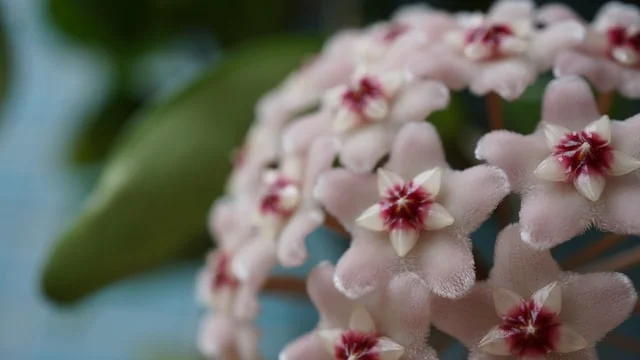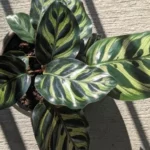Table of Contents
How to Care for Hoya Carnosa Compacta
Hoya carnosa compacta is one of the most famous varieties of the Hoya plant family. These plants are often called Porcelin Flower or Wax Flower due to the waxy, glossy appearance of their slightly succulent like leaves.
Hoya carnosa compacta plants are also known as Hindu Rope, which refers to the crinkled and rope like appearance of their fleshy, densely packed leaves along its vines.
Under the proper conditions, the plant is also capable of producing beautiful, star-shaped, sweet-smelling blooms several times a year.
The sweetness of the plant’s flowers is attributed to nectar, which when grown outdoors can attract wildlife such as hummingbirds.
The plantshave a native range that stretches from Australia through East Asia. Though grown as a perennial houseplant in most areas, Hoya carnosa compacta is actually an evergreen semi-succulent vine that often grows as an epiphytic on other trees, for this reason they do particularly well when cultivated at height or in a hanging basket.
What Does Your Hoya Carnosa Compacta Require?
Light Requirements
Hindu rope will do best in bright indirect light but can be made to tolerate much less light.
Consider the following tips for your Hoya carnosa compacta’s light requirements:
- Place your plant in or near an east-facing window where it will get bright (but indirect) sunlight for at least four to five hours a day.
- If your plant shows signs of sun spotting, try filtering sunlight through a sheer curtain.
- Morning sun is preferred for this plant.
- The lower the light is in Hoya carnosa compacta’s environment, the slower the plant will grow
- Good lighting is crucial for cultivating blooms. However, do not move a plant that has bloomed, as this may cause the flowers to fall off or die.
Temperature Requirements
Hindu rope is native to warm humid regions and does best in an environment that mimics these conditions, luckily it also is known to grow quite happily at usual household temperatures.
The following is important to remember about your plant’s temperature needs:
Indoors
- Hoya carnosa compacta will be happy in a range between 65- and-85 degrees Fahrenheit.
- Hoya carnosa compacta can survive temperatures down to 50 degrees Fahrenheit for brief periods of exposure.
- Try to moderate your plant’s natural day and night temperature cycle by keeping its environment about 10 degrees cooler at night.
- Protect your plant from sudden temperature changes. Be sure not to place it on or near radiators or drafts.
Humidity Requirements
Hoya carnosa compacta requires humidity at a slightly higher level than found in your average home. The plants will be best cultivated in a 40-60% humidity range.
If you have trouble attaining the proper level of humidity, try the following:
- Place your plants pot on a bed or tray of pebbles and keep the pebbles in water to raise the humidity level.
- Hoya carnosa compacta will do best in a naturally high-humidity environment, such as a bright bathroom windowsill.
- Consider placing your plant in a room with a humidifier.
- As a last resort you may choose to mist manually in the immediate vicinity of your plant, being careful not to let water sit on its leaves.
Soil Requirements
As an epiphyte plant Hoya carnosa compacta have very specific needs when it comes to their potting medium. These plants have very complex root systems that actually require some air flow around them, thus they do best in an open potting medium.
For the above reasons, it is best to respect these rules when potting your plant:
- DO NOT simply place Hoya carnosa compacta in a conventional houseplant potting mix. Regular potting medium will compact and be far too thick and weighty of a soil and because of this it will retain too much water for your plant’s root system.
- DO NOT use soil that will compact, these plants prefer space in and between their potting mediums.
- The best potting medium is a mix of distinct mix of materials normally used to aid drainage of plants such as pumice, perlite or even ceramic balls.
- Use a slightly smaller pot than usual, as these plants bloom best when slightly pot bound.
- Make sure your plant is potted in a container that has drainage hole and be sure to regularly monitor drainage holes for root blockage.
How to Water
As a semi-succulent, the Hoya carnosa compacta can get by on relatively little water. If you wish to enjoy the plant’s colorful blooms, however, it is best to water regularly during the growth season.
The following guidelines should help you decide when to water your Hindu rope:
- Allow your plant to dry out slightly between watering, then soak it thoroughly roughly every five to seven days.
- Water your plant until you see a pool start to form in its tray. Never leave your plant in standing water for more than fifteen minutes.
- The higher the humidity the less your Hoya carnosa compacta will need to be watered.
- You can ratchet down watering during the winter season to approximately once or twice bi-weekly.
How to Fertilize
Hoya carnosa compacta requires a specific type of fertilizer for its feedings. While you may be able to use a highly diluted, water-soluble fertilizer in a pinch, it really is best to give this plant a fertilizer specifically designed for epiphyte plants.
Such fertilizers can be found at any reputable garden center. Fertilizing can be done monthly at low doses during the spring and summer growth season. Do not fertilize in the winter.
Extra Care Tips for Hoya Carnosa Compacta
Pests & Diseases
In terms of pest and disease prevention for your plant, the most crucial step you can take is to vigilantly monitor its leaves. This is because Hoya carnosa compacta’s ovate and twisting leaves are the perfect hiding space for pests such as mealybugs and spider mites.
Another issue to look out for is the plants finicky root system, be sure to keep the roots from sitting in water or living in too wet of a potting medium. When repotting be sure to take care of the plant’s roots and avoid breaking them up as you might usually.
Pruning
Pruning is not strictly necessary for your Hoya carnosa compacta’s health but doing so can help improve the look of your plant.
Remember the following guidelines when pruning your plant:
- Do not prune outside of the spring as this will not allow your Hindu rope time to grow back enough.
- Be careful of pruning spurs, stems that blooms come from, as doing so will reduce the number of flowers your plant can produce.
- Conventional wisdom says that older spurs produce more flowers than newer spurs.
- Always use a sterile pruning scissors that has been cleaned before and after every use.
Propagation
The best way to propagate your Hoya carnosa compacta is to take a cutting during pruning. This can be accomplished by cutting a four-inch section of stem, removing most of its leaves and placing it in a sterile potting medium to take root.
Place your cut specimen in a dry, warm, room where it will receive some indirect light. Mist it if soil becomes dry.
When you notice new growth on your cutting it is time to move it to a more permanent container.



